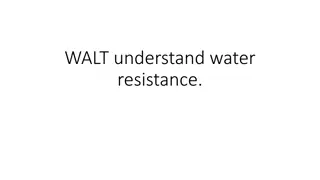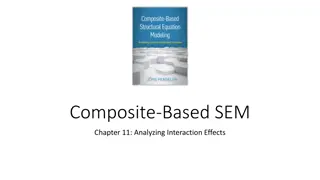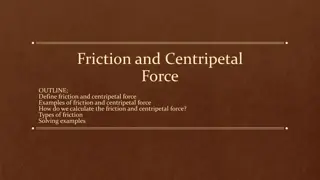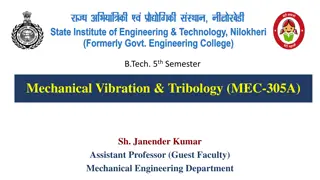Understanding Inclined Planes and Friction Forces
Introduction to inclined planes, components of forces, dealing with friction on whiteboards, and demonstrations on block forces on inclined planes. Learn about calculating components of gravity, friction forces, and scenarios involving kinetic and static friction on an inclined plane.
3 views • 11 slides
Water Pipeline System Design and Analysis Exercises
This exercise set explores various scenarios related to water pipeline systems, including connecting reservoirs, parallel and series connections, flow rate calculations, friction losses, power requirements for pumping, and more. The exercises cover topics like pipe diameter, length, friction factors
1 views • 5 slides
Understanding Tribology: The Science of Interacting Surfaces
Tribology is the study of friction, lubrication, and wear of surfaces in relative motion. It plays a crucial role in various industrial applications, with economic significance and implications on failure rates in engineering systems. The discipline focuses on surface interactions, forces transmissi
1 views • 41 slides
Understanding Clutches: Types and Functions
Clutches play a crucial role in connecting and disconnecting driving shafts, with various types like positive and friction clutches. Positive clutches, such as jaw clutches, ensure direct drive, while friction clutches like disk clutches use frictional material to engage and disengage shafts. Learn
0 views • 14 slides
Applications of Forces in Limiting Equilibrium for Solving Rigid Body Problems
Explore the principles of limiting equilibrium in rigid bodies with practical examples involving forces and friction. Learn how to analyze and solve problems, such as determining reaction forces and coefficients of friction, to ensure stability and balance in mechanical systems.
1 views • 8 slides
Investigating Friction: A Hands-On Experiment
Explore the concept of friction through a hands-on investigation, comparing surfaces to understand how texture affects movement. Discover how different surfaces create varying amounts of friction and how it impacts ease of movement. Predict, experiment, and observe to deepen your understanding of th
1 views • 15 slides
Understanding Frictional Forces and Equilibrium Principles in Physics
Explore the concepts of frictional forces and equilibrium in physics with a focus on conditions for forces acting on a body associated with friction. Learn about limiting frictional force, coefficient of friction, and the equilibrium of a body on horizontal and inclined planes. Delve into scenarios
2 views • 9 slides
Understanding Friction Clutches in Power Transmission
Friction clutches play a vital role in transmitting power in machines, especially those requiring frequent starting and stopping. They use friction to smoothly start driven shafts without excessive slipping. Different types of friction clutches, like disc or plate clutches, cone clutches, and centri
0 views • 26 slides
Understanding Water Resistance in Everyday Life
Water resistance is a type of friction experienced when objects move through water, similar to air resistance. This force slows down objects moving through water, like when swimming. Animals and humans adapt by using streamlined designs to reduce water resistance. Experimenting with different shaped
1 views • 11 slides
Understanding Non-Dimensional Numbers in Fluid Mechanics
Non-dimensional numbers play a crucial role in understanding fluid motion. This includes Reynolds Number for inertia and viscous forces, Froude Number for gravity effects, Cauchy Number for compressible flows, and Mach Number for elasticity forces. These numbers help in analyzing pipe friction, flow
1 views • 10 slides
Understanding Friction: Basics and Coefficients Explained
Friction is a force that opposes motion, influenced by surface texture and normal force. The coefficient of friction varies for objects at rest versus in motion. Learn about static and kinetic friction, key concepts, and how to solve friction problems step by step.
1 views • 19 slides
Understanding Friction Spinning Process and Technologies
Friction spinning is a textile manufacturing process that involves opening, accelerating, collecting, twisting, and winding fibers to create yarn. This process includes operations like fiber strand opening, acceleration, and collecting into a new strand, followed by imparting strength through twisti
1 views • 29 slides
Analyzing Interaction Effects in Composite-Based SEM
Explore the concept of interaction effects in composite-based structural equation modeling (SEM) through topics like the logic of interaction, estimating effects, multigroup analysis, and visualizing effects. Learn about moderators, their role in relationships between variables, and techniques for a
1 views • 23 slides
Understanding Tablet Compression and Compaction in Modern Pharmaceutics
This educational material delves into the physics of tablet making, focusing on the forces involved, compaction profiles, and effects of friction. Students will gain knowledge about tablet compression, compaction, and consolidation, including the types of forces at play and the distribution of force
0 views • 16 slides
Understanding Temperature and Friction in Metal Forming Processes
Metal forming processes are influenced by temperature and friction. At different temperature ranges, such as cold, warm, and hot working, the mechanical properties and forming behaviors of metals vary significantly. Cold working offers advantages like higher accuracy and strength, while warm working
0 views • 7 slides
Global Friction Materials Market
\"The Global Friction Materials Market Size is Anticipated to Exceed USD 92.60 Million by 2033, Growing at a CAGR of 4.90% from 2023 to 2033.\n\"\n
0 views • 5 slides
Understanding Forces and Friction on Inclined Planes
Explore the concept of forces and friction on inclined planes, focusing on the terminology and calculations involved. Learn how to resolve forces parallel and perpendicular to the plane, split gravity components, and consider normal reactions. Practice problems included to facilitate understanding.
0 views • 9 slides
Understanding Machines: Work, Forces, and Efficiency
Machines play a vital role in making work easier by increasing force, distance, or changing the direction of applied force. Different types of machines like levers, pulleys, and inclined planes simplify work processes. Understanding input and output forces, as well as input and output work, is essen
1 views • 10 slides
Understanding Friction and Centripetal Force in Physics
Friction is the force that opposes the motion of objects, while centripetal force is essential for circular motion. Types of friction include static, sliding, rolling, and fluid friction. We calculate friction and centripetal force using specific formulas. Examples like walking and writing illustrat
0 views • 18 slides
Understanding Interaction Effects in Regression Analysis using SAS 9.4
Regression models help analyze effects of independent variables (IVs) on dependent variables (DVs, like weight loss from exercise time). Interactions explore how one IV's effect can be modified by another IV (moderating variable, MV). In this seminar's purpose, techniques to estimate, test, and grap
0 views • 137 slides
Energy Conservation and Friction in Circular Motion
Explore the concepts of energy conservation, friction, and circular motion. Understand the role of friction in determining motion and the difference between centripetal and centrifugal forces. Learn about kinetic energy, potential energy, and the conservation of energy in various scenarios, such as
0 views • 23 slides
Understanding Forces and Motion on Rough Ramps
Explore the impact of friction forces on blocks sliding at different speeds on rough ramps. Learn about the direction of friction forces and how they affect the motion of objects both sliding down and up the ramp. Additionally, discover how friction comes into play when a block is motionless on a ro
1 views • 6 slides
Understanding Forces: Effects of Multiple Forces on Objects
Exploring the impact of multiple forces on objects through scenarios involving friction, pushing, and pulling. Students investigate the role of gravity and analyze how different forces influence the movement or stability of objects. The lesson includes hands-on activities and discussions to deepen u
0 views • 10 slides
Friction Stir Welding of Aluminum Plate: COMSOL Simulation
Manufacturers use friction stir welding to join aluminum plates efficiently. This modern method generates frictional heat to soften the aluminum, allowing dissimilar materials to be welded together. The model in COMSOL considers heat transfer and boundary conditions to simulate the welding process,
0 views • 8 slides
Understanding Fanno and Rayleigh Lines in Adiabatic Flow
Fanno and Rayleigh lines on the h-s diagram help in analyzing adiabatic flow with friction effects. The Fanno line represents frictional flow, while the Rayleigh line signifies non-adiabatic, frictionless flow. These lines aid in plotting flow properties and understanding phenomena like shock waves
0 views • 6 slides
Advanced Solutions for Concrete Dam Assessment
Utilizing advanced methods for the assessment of existing concrete dams is crucial for ensuring their stability and safety. This project focuses on analyzing the stability of small concrete dams in Norway built between 1950-1970, which may not meet current safety standards. The study involves evalua
0 views • 12 slides
Understanding Media Effects on Development: Strong, Limited, and Nil Impact (Continuation)
American psychologists have traditionally believed in strong media effects, attributing direct influence on audiences. However, the limited effects theory emerged in the 1940s, challenging this notion by suggesting media's negligible impact on behaviors such as voting. On the other hand, proponents
0 views • 6 slides
Physics Problems: Energy, Kinematics, and Work
Calculate the distance a baseball player slides using energy considerations and kinematic equations. Determine the initial speed of a gymnast on a trampoline, find the speed at which a motorcyclist strikes the ground after a jump, and analyze speed changes in ideal roller coaster scenarios. Explore
0 views • 5 slides
Understanding Friction: What Makes Moving Objects Slow Down?
A force called friction, created by bumps on surfaces interacting, is what causes moving objects to slow down and eventually stop. This lesson explores the concept of friction, its role in affecting motion, and how it varies on different surfaces. By investigating friction, students learn about its
0 views • 9 slides
Understanding the Effects of Multiple Forces on Objects
Exploring the impact of multiple forces acting on an object through engaging scenarios, investigations, and discussions on friction. Discover how forces interact and affect everyday movements, such as pushing a heavy file cabinet. Delve into the concept of friction and its role in motion, using prac
0 views • 15 slides
Understanding Forces and Stopping Distances in Vehicle Safety
Explore the forces that oppose vehicle motion, and learn about thinking distance, braking distance, and stopping distance. Discover how factors affect these distances, such as friction and reaction time. Gain insights into how friction helps in braking systems and the impact of accelerating or braki
0 views • 16 slides
Understanding Friction Dynamics in Physics
Explore the concepts of friction dynamics in physics, including solving problems with moving objects using principles such as F=ma and the suvat model. Learn about limiting equilibrium, coefficients of friction, and acceleration calculations for various surfaces. Dive into scenarios involving forces
0 views • 21 slides
Collective Effects in High-Energy Physics Facilities
Collective effects play a crucial role in Higgs factories and high-energy physics facilities. Impedance effects are proportional to beam-induced voltage, with peak bunch current impacting SB effects and average current affecting MB effects. Factors like beam loading compensation and detuning of the
0 views • 5 slides
Comprehensive Overview of Two-Phase Flow Equations and Gas Pipeline Hydraulic Analysis
Explore the general flow equations for two-phase flow in pipes and gas pipeline hydraulics. Understand concepts such as internal energy, kinetic energy, potential energy, entropy, and friction factors. Learn about pressure gradients, Reynolds numbers, and friction factors in single-phase gas flow. G
1 views • 26 slides
Economic Aspects of Tribology and Types of Lubrication in Mechanical Engineering
Understanding the economic impact of friction and wear on machine parts is crucial to preventing costly failures in manufacturing industries. Implementing tribological strategies can help reduce these failures. The types of lubrication, such as boundary, hydrostatic, and hydrodynamic, play key roles
0 views • 14 slides
Understanding Mechanical Linkages in High-Performance Manufacturing
Explore the world of mechanical linkages, including the effects of friction on machine operation, operation of machine linkages, and the roles of cams and turnbuckles. Friction is discussed as a force affecting everyday tasks, while cams and camshafts are highlighted for their role in sewing machine
0 views • 8 slides
Friction in Theory of Machines by Wessam Al Azzawi
Explore the role of friction in theory of machines through Wessam Al Azzawi's detailed discussion on chain and sprocket mechanisms, as well as the function and importance of brakes in controlling motion and speed. Dive into the intricate relationship between artificial frictional resistance and mach
0 views • 17 slides
Understanding Forces and Their Applications
Forces are pushes or pulls that can cause objects to speed up, slow down, change direction, or shape. They are measured in newtons (N) using a newtonmeter. Various types of forces include contact, tension, electrostatic, friction, and gravitational forces. Forces always occur in pairs, with equal an
0 views • 46 slides
Understanding Wheel and Axle in Simple Machines
Wheel and axles are simple machines that convert circular motion into forward motion, reducing friction and allowing for easier movement of heavy objects. They work by spinning the axle attached to a wheel, transferring force over a larger distance. Examples of wheel and axles in daily life include
0 views • 13 slides
Understanding Tribology: Friction, Wear, and Lubrication in Mechanical Engineering
Mechanical Vibration & Tribology delves into the science of interacting surfaces in motion, focusing on friction, wear, and lubrication. Tribology aims at controlling friction, preventing wear, and optimizing lubrication to enhance equipment reliability and reduce breakdowns.
0 views • 18 slides







































